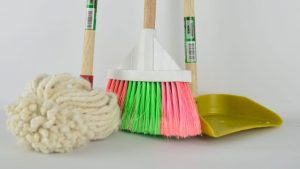One of my most memorable trips was a visit to Officina Profumo Farmaceutica of the Santa Maria Novella Church in Florence. Listed as one of the world’s oldest pharmacies, this apothecary & pharmacy was founded in 1221 A.D. by the Dominican Friars who started making herbal remedies and potions for use in the monastery. With a growing reputation that crossed borders, the Santa Maria Novella Pharmacy finally opened its doors to the general public in 1612, sponsored by the Grand Duke of Tuscany.
When I visited the Pharmacy in 2009, I was in awe of the nearly 400 year old heritage of creating creams, lotions, soaps and scents. This acute sense of history was heightened as we had just visited the church next door where we took in works by Botticelli, Vasari & Brunelleschi among others. The products continued to be plant based, many of their best sellers were recipes crafted hundreds of years ago by the Dominican Friars, and they continued to be made in small batches, by hand using locally available plant based ingredients.

In the medieval time Western homes, beauty and household care products were the realm of the Women of the home. A “still room” was an essential part of a home’s building plans, and it would be carefully constructed in a cold, dry part of the home, often in the basement, to store the medicines, potions, remedies and special food that were concocted in the home.
The cleaning products for the home like the concoction used to clean the silver, the special shaving soap used by the gentlemen of the home, the healing tisanes and teas, and the many many remedies for taking care of both large and small aches, pains and diseases were created in the “Still Room”. The recipes were carefully handed down the generations and were often a closely guarded, secret.

The Indian tradition was somewhat different from the western tradition especially in the plains. Because of the large bounty of plants across seasons with specific properties tailored for the seasons, our basket of remedies was very wide and varied. Given the hot and humid climate in our plains, our method of preparing our remedies and mixtures was also different from the western herbalism – we preferred tinctures or decoctions to tisanes. Apart from standardised products and medicines for hair and skin care and to cure ailments that were used from the Ayurveda, Siddha and Unani texts, we also had an Indian system of herbalism that was used for treating small ailments and personal care routines. This system of herbalism differed by geography and depended upon the local flora peculiar to the region.
So someone living in the South of India may have made hibiscus flower hair oil to prevent hair fall and other problems. Whereas, someone living in Chattisgarh, might have used the locally available dried Safflower in coconut oil to prevent hair fall and related problems.
As I continue to research India’s intricate connection with plants and nature and how we depended on the banquet offered by nature to clean, care for and maintain our homes and ourselves, I also realise that this connection is now becoming very tenuous.
Surveys done among several tribal groups across India reveal that the younger generation prefer to buy OTC or prescription capsules or pills to treat their ailments. And far from taking the trouble to pick a safflower and boil it in oil, they prefer to resort to an advertised cure for hair fall or a hair treatment product.
The columns in popular magazines and newspapers on beauty reveal our fascination with natural remedies – despite the onslaught of advertising and claims of superiority, we continue to faintly remember our tradition of the power of plants to take care of our hair, skin and bodies. But when it comes to taking care of our homes or treating our ailments, we have nearly forgotten the wealth of plants that we have around us.
As we like to say at Krya, Man (and Woman) has thrived for thousands of years before the arrival synthetic, industrially manufactured products. The chemical consumer product industry is about 150 years old and really started coming into its own during the First World War with shortages in basic commodities forcing inventions.
The first archaeological proof of the existence of soap in the Western world was in ancient Babylon, 4800 years ago. A ancient soap vat was found with inscriptions detailing how animal fat was to be boiled with ash to produce soap. The Ebers Medical Papyrus dated from 1500 BCE in ancient Egypt describes creating soap like material by mixing animal and vegetable oils with alkaline salts like, Natron, a naturally occurring mixture of different sodium salts.
Natron was a panacea in Ancient Egypt. It was harvested from dried lake beds, typically in Wadi El Natrun, a valley in the Beheira govern ate in Egypt, and was used for thousands of years in ancient Egypt to clean both the home and the body. Blended with oil, it formed an early form of soap which softens water and helps remove oil and grease. Undiluted it helped clean teeth and was made into a simple mouthwash. It was used variously in the home from an antiseptic for minor cuts and wounds, to helping preserve and dry fish and meat. Natron was also used in Egyptian mummification procedures to absorb water and ensure dry conditions.

Since India was blessed with an abundance of plant life, different parts of India developed combinations of plants, with some minerals and ashes as cosmetic aids and to maintain clean homes.
The Soapberry tree has long been revered in Indian tradition and in Ayurveda as being an excellent cleanser for skin and hair. Sapindus trifoliatus, the south Indian soapberry, which we use extensively in our formulations at Krya, has been noted as a healing cleansing ingredient and has been recommended in Ayurveda to cure specific skin conditions like psoriasis.
Different species of Acacia form the soap pod or the Shikakai bush. It continues to be grown as a hedge plant in remote villages where its extensive set of thorns protects homes from the entry of wild animals like wild pigs. The soap pod is again extensively documented in both Ayurveda and Siddha. With its mild cleansing action and a varied set of saponins, Shikakai is used in hair and skin cleaning formulations, as a wound healer and bactericidal agent in infusions for oral care.

Our research at Krya aims to create new and interesting formulations to help you care safely and sustainably, have thrown up many more natural soap substitutes. These include different kinds of wild tubers, other fruits, and sometimes even ashes of particular plants that have long been used inventively by the communities that have access to them. And all of these plant soaps are used to variously wash woollens, as a safe shampoo, to clean dishes, and to bathe the delicate skin of babies.
We are facing a crisis of great proportion today. And this crisis has to do with the choices we have made collectively as a race. By voting to put our faith and money behind products that have been manufactured inside a chemical facility without a long-term understanding of their safety, we have given away control of our life, our health and our planet. This lack of control has led to several alarming consequences for us and the planet.
Researchers from the U.S studied a small sample of 6 cleaning products used in a typical home and found that this group emitted 133 Volatile organic compounds (VOCs). Each of the 6 cleaning products tested emitted between 1 to 8 chemicals that are classified as toxic or hazardous under US Federal Laws.
Ammonia
Ammonia is a common substance found in homes, emitted from synthetics like toilet cleaners, drain cleaners, window cleaners and specialised oven & stainless steel cleaners. These vapours may irritate the skin, throat, eyes, and lungs and can irritate people with asthma.
Coal tar dyes, are commonly found in almost all cleaning products giving them the bright, shiny, metallic colours that we seem to like. Your bright green dishwash or shampoo derives its colour from petrochemicals which can be contaminated with traces of heavy metals like arsenic, lead and cadmium. There is a concern that these synthetic dyes may be carcinogenic and the heavy metal contamination in them can harm the nervous system. These dyes can be absorbed through your skin or even worse, ingested as residue when your dishes or plates are not rinsed thoroughly. Worse still, from the point of view of the effectiveness, these dyes are completely unnecessary and have no relevance to how well a product cleans.

2-Butoxyethanol (or 2-BE, also known as Butyl Cellosolve)
This is a skin and eye irritant that is associated with blood disorders and has caused reproductive problems in lab animal experiments. This chemical is listed as a toxic substance under the Canadian Environmental Protection act as it is harmful to human health. The main way it enters our system is by inhaling the air inside our homes (which are contaminated by the use of the products that contain this chemical) and by direct skin contact with the leaning products we use. In Canada, 2-BE concentration is limited to 6%, but certain products like laundry stain digesters and stain removers can carry this chemical upto 22%.
Consumer product industry in India – still poorly regulated
The consumer product Industry in India continues to be under regulated. While the manufacturing of certain household products like detergents are classified by the ministry of Environments and Forests as a polluting industry with the symbol “Red” (highly polluting), there is still a lot of work to be done before we can reach the safety and human health standards set by countries like Canada.
Cleaning and consumer products do not require any ingredient listing. Safety standards have not taken into account the continuing research and environmental implications of using the multitude of chemicals that go into the products we use today. Companies are penalised only when they fail to follow basic hygiene standards, such as a bacterial count that exceeds permissible limits or the presence of a foreign object inside the product to be used.
Environmental activists continue to wage a war to get companies to follow decent standards of formulation that are followed as a matter of course all over the world. For example, phosphates which have been banned in many developed countries as their excessive use in cleaning products leads to water pollution and eutrophication are used in excess in India. Regulations in U.S and Canada limit the use of phosphates in foaming cleaning products like detergents and dishwash products to fewer than 2.5%. In India the phosphate levels in these products routinely exceeds 40% – Phosphate is used as a cheap builder and water softener to productive large amounts of lather in a cleaning product. Of course, as with the example of coal tar dyes, this lather is unnecessary and does not signify better cleaning.
The Krya “Try this instead” series has 3 aims: Information, Hope & Inspiration
1. To inform you about the dicey and nasty chemicals used many of the products that enter our homes today. We believe that this information will empower you to make better choices. So we aim to arm you with information, facts and research to help you navigate your way through the Chemical wasteland of products when you next navigate your supermarket.
2. To give hope (and safe alternatives) – Sometimes when confronted with information like the above, we tend to fall into an abyss of despair. Are we to no more have fun and use shiny fragrant products we ask ourselves? Will I never have a sweet, gel-based toothpaste again? How are we supposed to now clean ourselves and our homes? This series hopes to give you good workable alternatives: in the form of ingredients, hacks or products that you can use in multiple ways across your home. For example, we use the Krya detergent like a swiss army knife in various combinations to clean our clothes, dishes, floor, bathrooms, hair and teeth by adding simple herbs for each of these functions. We will be writing about simple ideas and recipes such as the above.
3. Most importantly, to inspire you. The true Wealth of India, its plants, herbs and trees, have been variously catalogued by the British in their time and several ethno botanists and anthropologists today as its rich biodiversity of plants and the rich native knowledge of how these herbs can be used to lead a healthy, happy and clean life. In our quest to create Krya and lead a more natural and clean life, we have been amazed and inspired by this true Wealth of India – we celebrate this wealth every day, and hope to inspire you with this series to do the same.
We hope you will enjoy and appreciate this new series as you have with our past writings. Please do write to us and let us know if there are any particular areas you would like us to cover within the scope of the subject and we will be happy to do so. A happy, organic, natural, safe and clean day to you too.
THANK YOU FOR SIGNING UP
Get More Ayurvedic wellness advice
with




